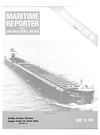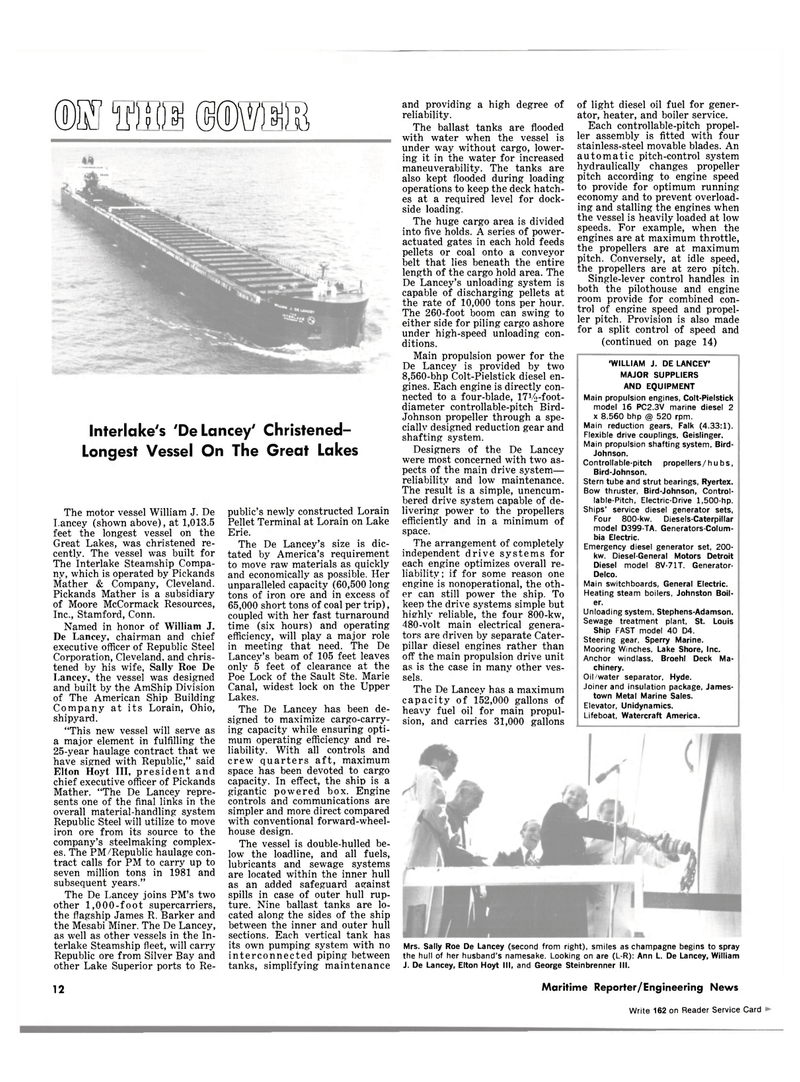
Page 10: of Maritime Reporter Magazine (June 15, 1981)
Read this page in Pdf, Flash or Html5 edition of June 15, 1981 Maritime Reporter Magazine
®K3 @®WHB
Interlake's 'De Lancey' Christened-
Longest Vessel On The Great Lakes
The motor vessel William J. De
Lancey (shown above), at 1,013.5 feet the longest vessel on the
Great Lakes, was christened re- cently. The vessel was built for
The Interlake Steamship Compa- ny, which is operated by Pickands
Mather & Company, Cleveland.
Pickands Mather is a subsidiary of Moore McCormack Resources,
Inc., Stamford, Conn.
Named in honor of William J.
De Lancey, chairman and chief executive officer of Republic Steel
Corporation, Cleveland, and chris- tened by his wife, Sally Roe De
Lancey, the vessel was designed and built by the AmShip Division of The American Ship Building
Company at its Lorain, Ohio, shipyard. "This new vessel will serve as a major element in fulfilling the 25-year haulage contract that we have signed with Republic," said
Elton Hoyt III, president and chief executive officer of Pickands
Mather. "The De Lancey repre- sents one of the final links in the overall material-handling system
Republic Steel will utilize to move iron ore from its source to the company's steelmaking complex- es. The PM/Republic haulage con- tract calls for PM to carry up to seven million tons in 1981 and subsequent years."
The De Lancey joins PM's two other 1,000-foot supercarriers, the flagship James R. Barker and the Mesabi Miner. The De Lancey, as well as other vessels in the In- terlake Steamship fleet, will carry
Republic ore from Silver Bay and other Lake Superior ports to Re- 12 public's newly constructed Lorain
Pellet Terminal at Lorain on Lake
Erie.
The De Lancey's size is dic- tated by America's requirement to move raw materials as quickly and economically as possible. Her unparalleled capacity (60,500 long tons of iron ore and in excess of 65,000 short tons of coal per trip), coupled with her fast turnaround time (six hours) and operating efficiency, will play a major role in meeting that need. The De
Lancey's beam of 105 feet leaves only 5 feet of clearance at the
Poe Lock of the Sault Ste. Marie
Canal, widest lock on the Upper
Lakes.
The De Lancey has been de- signed to maximize cargo-carry- ing capacity while ensuring opti- mum operating efficiency and re- liability. With all controls and crew quarters aft, maximum space has been devoted to cargo capacity. In effect, the ship is a gigantic powered box. Engine controls and communications are simpler and more direct compared with conventional forward-wheel- house design.
The vessel is double-hulled be- low the loadline, and all fuels, lubricants and sewage systems are located within the inner hull as an added safeguard against spills in case of outer hull rup- ture. Nine ballast tanks are lo- cated along the sides of the ship between the inner and outer hull sections. Each vertical tank has its own pumping system with no interconnected piping between tanks, simplifying maintenance and providing a high degree of reliability.
The ballast tanks are flooded with water when the vessel is under way without cargo, lower- ing it in the water for increased maneuverability. The tanks are also kept flooded during loading operations to keep the deck hatch- es at a required level for dock- side loading.
The huge cargo area is divided into five holds. A series of power- actuated gates in each hold feeds pellets or coal onto a conveyor belt that lies beneath the entire length of the cargo hold area. The
De Lancey's unloading system is capable of discharging pellets at the rate of 10,000 tons per hour.
The 260-foot boom can swing to either side for piling cargo ashore under high-speed unloading con- ditions.
Main propulsion power for the
De Lancey is provided by two 8,560-bhp Colt-Pielstick diesel en- gines. Each engine is directly con- nected to a four-blade, 17V2-foot- diameter controllable-pitch Bird-
Johnson propeller through a spe- cially designed reduction gear and shafting system.
Designers of the De Lancey were most concerned with two as- pects of the main drive system— reliability and low maintenance.
The result is a simple, unencum- bered drive system capable of de- livering power to the propellers efficiently and in a minimum of space.
The arrangement of completely independent drive systems for each engine optimizes overall re- liability; if for some reason one engine is nonoperational, the oth- er can still power the ship. To keep the drive systems simple but highly reliable, the four 800-kw, 480-volt main electrical genera- tors are driven by separate Cater- pillar diesel engines rather than off the main propulsion drive unit as is the case in many other ves- sels.
The De Lancey has a maximum capacity of 152,000 gallons of heavy fuel oil for main propul- sion, and carries 31,000 gallons of light diesel oil fuel for gener- ator, heater, and boiler service.
Each controllable-pitch propel- ler assembly is fitted with four stainless-steel movable blades. An automatic pitch-control system hydraulically changes propeller pitch according to engine speed to provide for optimum running economy and to prevent overload- ing and stalling the engines when the vessel is heavily loaded at low speeds. For example, when the engines are at maximum throttle, the propellers are at maximum pitch. Conversely, at idle speed, the propellers are at zero pitch.
Single-lever control handles in both the pilothouse and engine room provide for combined con- trol of engine speed and propel- ler pitch. Provision is also made for a split control of speed and (continued on page 14) 'WILLIAM J. DE LANCEY'
MAJOR SUPPLIERS
AND EQUIPMENT
Main propulsion engines, Colt-Pielstick model 16 PC2.3V marine diesel 2 x 8,560 bhp @ 520 rpm.
Main reduction gears, Falk (4.33:1).
Flexible drive couplings, Geislinger.
Main propulsion shafting system, Bird-
Johnson.
Controllable-pitch propellers/h ubs,
Bird-Johnson.
Stern tube and strut bearings, Ryertex.
Bow thruster, Bird-Johnson, Control- lable-Pitch, Electric-Drive 1,500-hp.
Ships' service diesel generator sets,
Four 800-kw. Diesels-Caterpillar model D399-TA. Generators-Colum- bia Electric.
Emergency diesel generator set, 200- kw. Diesel-General Motors Detroit
Diesel model 8V-71T. Generator-
Delco.
Main switchboards, General Electric.
Heating steam boilers, Johnston Boil- er.
Unloading system, Stephens-Adamson.
Sewage treatment plant, St. Louis
Ship FAST model 40 D4.
Steering gear, Sperry Marine.
Mooring Winches, Lake Shore, Inc.
Anchor windlass, Broehl Deck Ma- chinery.
Oil/water separator, Hyde.
Joiner and insulation package, James- town Metal Marine Sales.
Elevator, Unidynamics.
Lifeboat, Watercraft America.
Mrs. Sally Roe De Lancey (second from right), smiles as champagne begins to spray the hull of her husband's namesake. Looking on are (L-R): Ann L. De Lancey, William
J. De Lancey, Elton Hoyt III, and George Steinbrenner III.
Maritime Reporter/Engineering News
Write 162 on Reader Service Card

 9
9

 11
11
